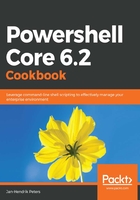
How it works...
PowerShell and its incredibly flexible system are easily discovered with the help of Get-Command. Even for a seasoned PowerShell expert, Get-Command is invaluable as it works on any system, doesn't need additional content, and will save you precious time. Additionally, nobody is able to just know all existing cmdlets—sometimes, you just need to have a short look at the syntax.
Aliases are a part of PowerShell as well as cmdlets. Sometimes, an alias is introduced when the name of a cmdlet changes in order maintain backward compatibility to some degree. Other aliases are simply created to make working interactively faster or to ease the migration from another scripting language such as the aliases, dir and ls.
By inspecting module manifests and module definitions, Get-Command is able to discover the exported cmdlets of a module that make up the available cmdlets on a system. Additionally, the PATH environmental variable is used to discover external applications such as executables, libraries, and text files.
The output of Get-Command can simply be filtered with wildcards in order to discover cmdlets that have a certain purpose, for example, *Process will list all cmdlets that have something to do with processes.
One parameter that you should always use is the Syntax parameter. Reading the cmdlet syntax is one of the easiest ways to determine how the cmdlet can be used, what its mandatory parameters are, and what its parameter values should look like.